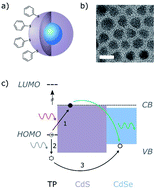NIR-to-visible upconversion in quantum dots via a ligand induced charge transfer state†
Abstract
Nanomaterials that possess the ability to upconvert two low-energy photons into a single high-energy photon are of great potential to be useful in a variety of applications. Recent attempts to realize upconversion (UC) in semiconducting quantum dot (QD) systems focused mainly on fabrication of heterostructured colloidal double QDs, or by using colloidal QDs as sensitizers for triplet–triplet annihilation in organic molecules. Here we propose a simplified approach, in which colloidal QDs are coupled to organic thiol ligands and UC is achieved via a charge-transfer state at the molecule–dot interface. We synthesized core/shell CdSe/CdS QDs and replaced their native ligands with thiophenol molecules. The alignment of the molecular HOMO with respect to the QD conduction band resulted in the formation of a new charge-transfer transition from which UC can be promoted. We performed a series of pump–probe experiments and proved the non-linear emission exhibited by these QDs is the result of UC by sequential photon absorption, and further characterized the QD–ligand energy landscape by transient absorption. Finally, we demonstrate that this scheme can also be applied in a QD solid.



 Please wait while we load your content...
Please wait while we load your content...